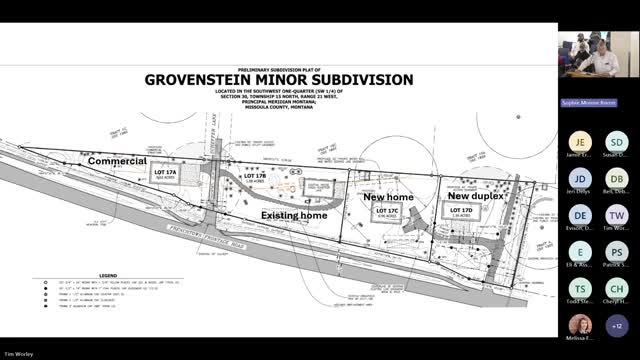Commissioners approve Grovenstein Minor Subdivision despite community zoning concerns
May 23, 2025 | Missoula County, Montana
This article was created by AI summarizing key points discussed. AI makes mistakes, so for full details and context, please refer to the video of the full meeting. Please report any errors so we can fix them. Report an error »

The Missoula County Commissioners held a public meeting on May 22, 2025, addressing several key development proposals, including the Grovenstein Minor Subdivision and the Hidden Treasure Subdivision.
The meeting began with public comments regarding the Grovenstein Minor Subdivision. Several community members expressed concerns about the proposed commercial development, arguing that it does not fit the agricultural character of the area. One resident described the idea of a commercial building as "ridiculous," emphasizing the need to maintain the area's rural aesthetic.
Commissioner Tim raised important points about the limitations of zoning regulations, stating that the land in question is unzoned and does not have any encumbrances that would prevent development. He referenced historical discussions in Missoula regarding commercial development in residential areas, noting that similar projects, like Rattlesnake Gardens, have become valuable community assets over time. Tim moved to approve the Grovenstein Minor Subdivision based on the staff report's findings and conditions.
Commissioner Stromeyer seconded the motion, reiterating that the land is unencumbered and that the only restrictions pertain to sanitation, which falls outside the Commission's purview. He highlighted the potential benefits of small-scale commercial developments in residential neighborhoods, suggesting that they can enhance community life.
Following the motion and second, the Commissioners voted unanimously in favor of the Grovenstein Minor Subdivision.
The meeting then transitioned to the Hidden Treasure Subdivision, with planner Patrick Swart introducing the request for the minor subdivision at 875 Hidden Treasure Court. Further details on this proposal were expected to follow in subsequent discussions.
Overall, the meeting underscored the complexities of land use regulations and the ongoing dialogue between community interests and development opportunities in Missoula County. The Commissioners' decisions reflect a commitment to balancing these interests while adhering to legal frameworks governing land use.
The meeting began with public comments regarding the Grovenstein Minor Subdivision. Several community members expressed concerns about the proposed commercial development, arguing that it does not fit the agricultural character of the area. One resident described the idea of a commercial building as "ridiculous," emphasizing the need to maintain the area's rural aesthetic.
Commissioner Tim raised important points about the limitations of zoning regulations, stating that the land in question is unzoned and does not have any encumbrances that would prevent development. He referenced historical discussions in Missoula regarding commercial development in residential areas, noting that similar projects, like Rattlesnake Gardens, have become valuable community assets over time. Tim moved to approve the Grovenstein Minor Subdivision based on the staff report's findings and conditions.
Commissioner Stromeyer seconded the motion, reiterating that the land is unencumbered and that the only restrictions pertain to sanitation, which falls outside the Commission's purview. He highlighted the potential benefits of small-scale commercial developments in residential neighborhoods, suggesting that they can enhance community life.
Following the motion and second, the Commissioners voted unanimously in favor of the Grovenstein Minor Subdivision.
The meeting then transitioned to the Hidden Treasure Subdivision, with planner Patrick Swart introducing the request for the minor subdivision at 875 Hidden Treasure Court. Further details on this proposal were expected to follow in subsequent discussions.
Overall, the meeting underscored the complexities of land use regulations and the ongoing dialogue between community interests and development opportunities in Missoula County. The Commissioners' decisions reflect a commitment to balancing these interests while adhering to legal frameworks governing land use.
View full meeting
This article is based on a recent meeting—watch the full video and explore the complete transcript for deeper insights into the discussion.
View full meeting
